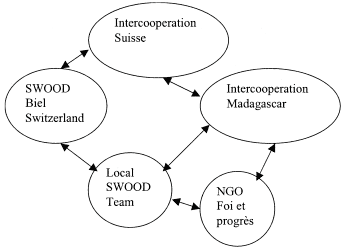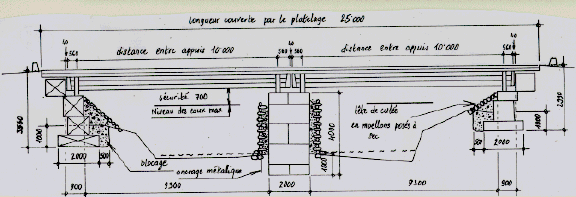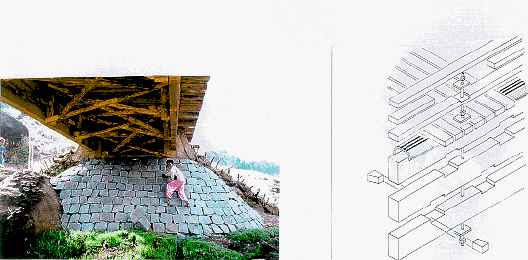

0666-A4
Maurice Brunner 1
In many developing countries, forests are deteriorating quickly, partly due to the predatory activities of timber exporting companies. The local people are also often to blame: timber is mainly seen as a cheap source of fuel, although there are many other pressing needs that could be satisfied by this versatile material. Between 1997 and 1999, the Swiss School of Engineering for the Wood Industry (SWOOD) in Biel received an assignment to develop a low-cost, small-span bridge for rural areas in Madagascar. Because of the difficulty in finding local qualified staff in the remote area, it was deemed advisable to use as simple technology as possible and to use timber directly from the nearby forests. Under the supervision of the author, two Malagasy engineering technicians and one SWOOD student joined hands to help build the bridge in Madagascar. The project shows that forests could help to solve a serious infrastructure problem in developing countries, rather than being used mainly as a fuel.
In many developing countries, there is a crying need for low-cost bridges across the many streams which are the main bottlenecks to transportation. Financial constraints often make it difficult to solve these problems. Governments and development agencies are becoming increasingly aware of the the need to apply appropriate, low-cost engineering solutions.
In 1997, the Development Agency Intercooperation Suisse in Bern launched a project with the Swiss School of Wood Engineering (SWOOD) in Biel to develop a low-cost, small-span bridge for rural and semi-rural urban areas in Madagascar, which could be realised by local artisans under engineering supervision. The bridges were to be designed for simple ox carts; barriers should be provided to prevent heavy lorries from using the bridge. Steel and concrete are expensive, imported goods in Madagascar: timber on the other hand is readily available locally at quite cheap prices. It therefore seemed logical to use as much timber as possible for the bridge design. Indirectly, it was also hoped that the project might help to upgrade the value of forests by making local politicians more aware of the many benefits of the forests.
The rather complex project organisation is illustrated in simplified form in fig. 1. The different parties had the following assignments:

Fig. 1: Project organisation
The project was divided into three clear stages:
During the winter semester 1997/98, under the guidance of SWOOD professors, two students in their 5th Semester of studies worked on possible solutions for the pilot bridge. They were joined by two engineering technicians who were flown in from Madagascar by Intercooperation Suisse. During five months these technicians underwent practical training in a Swiss timber construction firm in order to further their skills for the task ahead. Once a week they reported to the school to help in the development of the bridge concept. Their knowledge of local expertise and materials proved to be very useful. Together with the Swiss students, they built and tested a 1:1 scale model of the main bridge beam. They also helped to prepare a list of simple materials to be bought in Switzerland for later use in Madagascar.
As part of their study requirements, SWOOD students must undergo 1 year of practical training in industry (6th and 7th semesters of an 8-semester course). One of the two students who had worked on the project during the 1st stage was willing to spend this period in Madagascar. In April 1998, he and the two Madagascan technicians were formally employed by the Intercooperation Office in Madagascar. Their job was to organise and supervise the construction of a pilot object. The SWOOD student had as project for his degree the documentation of the experiences gained in the design and the construction of the bridge. The workers and artisans for the bridge were to be organised and paid by a local NGO called "Foi et progrès".
With the return of the SWOOD student to Switzerland to complete his studies, the task of building other bridges of similar span would be handed over to the two Madagascan technicians.
The bridge was built near the town of Faratsiho, which is about 150km south of Antananarive. The area is very fertile and produces food crops which are transported mainly by the 341 oxcarts of the region. Between December and March each year, the flooded waters of the Antsahalava river cut off several locations from the regional capital. The floods coincide with the potato harvest and prevent the farmers from selling their goods in Faratsiho. The impassable roads also prevent the sick from being sent to hospital in Faratsiho as well as the delivery of seeds, fertilisers and medicines to the outback. The need for a reliable bridge across the river is very apparent.
With the help of some resident Italian missionaries, the farmers of the regions have built up a well-organised non-governmental organisation "Foi et progrès". This fact was well received by the project financier Intercooperation Suisse, which as a matter of policy usually only helps underdeveloped areas in their own efforts to improve their situation. Intercooperation agreed to finance the SWOOD know-how and the materials under the condition that the NGO would organise and pay the workers and artisans who would do the actual construction work on site.
The bridge design was mainly done in Switzerland. The design work was based on a number of photograghs and manual measurements with a tape. From a number of variants, the final solution was chosen in the form of two continuous, simply supported beams of 10.5 m span (fig.2). After a site inspection and more accurate measurements with surveying instruments, a few changes had to be made in the details.

Fig. 2: Structural System of the pilot bridge
The substructure of the bridge, comprising the abutments and the central column, was entirely made with gabions which were filled with hewn rock blocks. The gabions were made by craftsmen in the capital city from galvanised steel wires imported from France (fig. 3). The rock was obtained from an improvised quarry on the left bank of the river (fig. 4). Apart from the low cost, gabions offered the technical advantage of being relatively insensitive to erosion hazards: the flexible foundations would just sink deeper into the eroded river bed.

Fig. 3: Workers weaving wires for gabions Fig. 4: Rock quarrying
The massive central column was 3 m high. It was founded on a rock in the middle of the river. Erosion protection was attained by surrounding it with a belt of timber logs filled in with rock material. The foundations of the abutments were protected with hewn rock blocks placed on the sides facing the river, whilst the road approaches were biologically protected from erosion hazards by planting mimosa bushes and tall grass on the slopes (Fig. 5). The river banks were stabilised with wooden stakes backfilled with earth.

Fig. 5: Erosion protection Fig. 6: Details of bridge beams
The bridge superstructure was made in timber: pinus keysia for the main beams and the stiffening, eucalyptus robusta for the surfacing. The main beams were shielded from rain water with old lorry tyres (Fig. 6).
The calculations were based on the Swiss Codes of Practice, which are quite similar to the Eurocodes: SIA 160 "Actions", SIA 161 "Steel Structures", SIA 164 "Timber Structures". The ox carts were idealised as four concentrated loads of 7.5 kN each, loading surface per load 100 mm x 100 mm, distance between the loads in both directions 1.5 m.
The two main girders in the cross section are composite beams: three sections with dimensions b x h = 120 mm x 200 mm are joined together with dowels of hard wood to prevent slippage. Steel bars help to hold the timber sections together. The members were designed with the truss analogy typically used for reinforced concrete design (fig. 7): the steel bars take up the tensile forces, whilst the dowels absorb the horizontal components of the diagonal forces.

Fig. 7: Truss analogy for the design of the main beams Fig. 8: Timber "workshop"
1500 man-days were needed to construct the bridge. No machines were used: all construction work was done by local manual labour. There were only a few skilled and experienced workers: a couple of carpenters and a mason. Most of the rest of the workers were farmers who came to help as labourers. They removed soil to make room for the foundations. The mason trained some of them to hew rock blocks which he used to fill the gabions. They transported materials around the site.
Seven trees with diameter around 600 mm were cut and the bark removed with special tools brought from Switzerland. In rural areas in Madagascar, the bark is not removed: a rectangular section is cut out with axes, and from this large piece smaller beams are cut. Removing the bark allowed the saving of three extra boards per tree. The "workshop" was just a clearing in the forest. The timber was arranged carefully in a pile to dry before being sawn to the final size (Fig 8).
Towards the end of the construction work, one could feel the intense pride the artisans felt for their work. The populace identified emotionally with their bridge. The figs. 10 and 11 show the river site before and after the bridge construction.
It was an economical solution. Most of the total budget of about US $ 55'000.- was spent on the preparatory work in Switzerland. In particular, much went into the 6-month training of the Malagasy technicians in Switzerland as well as to pay the salary of the Swiss student and the air flights involved. The local budget for the construction of the bridge was less than US $7'000.- or about US$140/m2 bridge surface. Nearly $6'000.- of the budget was not used up: it was later used by the Malgasy technicians to repair two other, smaller timber bridges in the area. Many of the building materials, in particular the timber and the rock, were obtained at no cost from the community land. The local artisans did most of the work on a voluntary basis, though the most skilled ones received some formal salary.

Figs. 10 and 11: Bridge site before and after the construction
The SWOOD student returned to Switzerland to complete his studies in March 1999. The responsibility for realising more projects was handed over to the Madagascan technicians, who have founded a consulting office in Antananarive for this purpose.
A few notes of comparison with the famous UNIDO modular bridge designed for developing countries ([3], [4]). The UNIDO bridge obviously has the wider, formal support of the United Nations, which has eased the realisation in many countries in Africa, Asia and Latin America. The SWOOD bridge project in Madagascar was an unexpected lucky chance: building bridges was not the main activity of the development agency in the area. The yearly budget for the normal activities in the area could not be used up completely: as a special exception, the excess money was used to comply with the local demand for a bridge. On a technical level, the UNIDO project is also rather more complex, involving higher wood processing such as drying techniques, cooperation with saw mills including glulam in some places, and including some more sophisticated joints than those of the SWOOD project, which relied on timber supplied directly from the forest by local artisans.
The number of timber bridges is still quite low in Madagascar. Hopefully more will be built in the future, thus helping to solve the critical transportation problems in the country. The increased use of timber to help solve otherwise expensive infrastructure problems may help to enhance the value of the forests in the eyes of the people and the politicians. The increased respect for the value of the forests may help to conserve forests in developing countries in general.
[1] ROULIER J.: "Projet ponts en bois à Madagascar", Travail de Diplôme, SWOOD, March 1999 (unpublished)
[2] BRUNNER M.: "Simple Timber Bridges for semi-rural urban areas in Madagascar" IABSE Congress Lucerne, September 2000.
[3] HALLET R. M.: "Development of Timber Contruction: Mission to the Republic of Chile", UNIDO Report Nr. 14981, 1985.
[4] HALLET R. M.: "Low-cost modular prefabricated wooden bridges BHUTAN", UNIDO Report Nr. 16903, 1988.
1 Professor for Strucural Analysis and Design, Swiss School of Engineering SWOOD, Biel, Switzerland. [email protected]